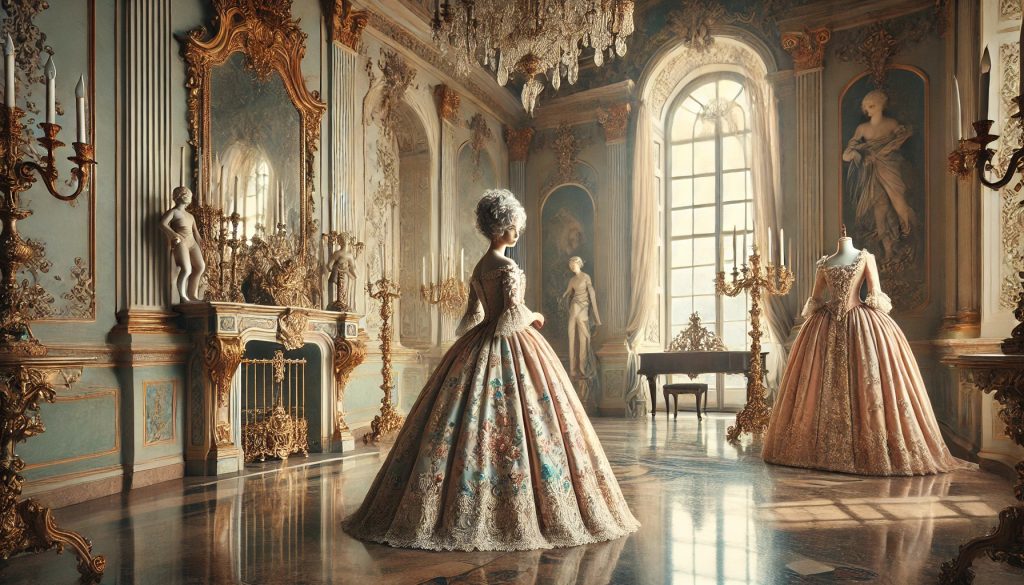Rococo emerged in France in the 1720s and remained the predominant style till it faded from the zeitgeist in the 1770s. Excessively flamboyant and characterised by asymmetric ornamentation and natural motifs, Rococo was a style without rules. Let us dive deeper into the features of rococo fashion

While Baroque fashion was characterised by darker, rigid styles, Rococo introduced a lighter, more relaxed aesthetic that celebrated individuality. The style featured intricate embroidery, fine lace, floral motifs, and elaborate fashion accessories, which appealed to the aristocracy’s fascination with romanticism.
TABLE OF CONTENTS
- What is Rococo fashion?
- Origin of Rococo Fashion
- Rise and Prominence of Rococo Fashion
- Prominent Designers of Rococo Fashion
- Significance of Rococo Fashion Today
- How to Incorporate Rococo Fashion into the Modern Wardrobe
What is Rococo fashion?
Rococo fashion, which flourished during the Eighteenth century, is characterised by its opulence, intricate detailing, and emphasis on elegance and playfulness. Women’s fashion during this period often featured voluminous gowns with wide panniers, designed to accentuate the hips and create a dramatic silhouette. These dresses were made of silk, satin, and taffeta, with elaborate embellishments like lace, ribbons, and floral embroidery. Pastel colours such as pale pink, light blue, and lavender were popular, giving the garments a delicate romantic feel. Accessories like wigs, decorative fans, and lavish jewellery further enhanced the air of extravagance associated with Rococo fashion.
For men, Rococo fashion involved equally elaborate designs. Tailored coats, known as justaucorps, were paired with knee-length breeches and waistcoats, made of embroidered or brocade fabrics. Shirts with ruffled cuffs and cravats added a touch of sophistication, while wigs, usually powdered white, were a staple of the era’s style. Men also favored gold trims, intricate buttons, and embroidered motifs inspired by nature, including flowers and vines. The overall aesthetic of Rococo fashion aimed to showcase wealth, social status, and a love for art and beauty, reflecting the era’s cultural focus on elegance and refinement.
Origin of Rococo Fashion

The origins of Rococo fashion can be traced back to early eighteenth-century France, where the Rococo art movement first developed as a reaction against the heaviness and drama of Baroque art and culture.
The term “Rococo” itself derives from the French word rocaille, referring to shell-like ornamentation that was often used in architecture and design during this time. This artistic influence quickly translated into fashion, as French aristocrats sought to embody the playful and ornate spirit in their clothing. The court of Louis XV served as a hub for the development of Rococo fashion, with courtiers adopting elaborate styles that symbolised wealth, sophistication, and cultural refinement.
Rococo fashion also drew inspiration from nature and mythology, evident in the use of floral embroidery, soft colour palettes, and ethereal fabrics. Women’s dresses, in particular, incorporated elements that reflected themes of romance and fantasy, such as cascading pleats, billowing skirts, and intricately designed bodices. Men’s fashion, too, embraced the ornate detailing of the Rococo period, with embroidery, lace cravats, and decorative wigs becoming staples of the aristocratic wardrobe.
Rise and Prominence of Rococo Fashion
The rise of Rococo fashion coincided with the growing influence of the French aristocracy in the 18th century. Paris, as the fashion capital of Europe, became the epicenter of this stylistic revolution. Women’s clothing became increasingly elaborate, with styles such as the robe à la franç opulence, elaborate designs, and a whimsical approach to design aesthetics, Rococo fashion mirrored the extravagance of the aristocracy under the reign of Louis XV of France.
This style was deeply rooted in the desire for luxury and leisure, focusing on soft curves, delicate patterns, and pastel hues. Both men’s and women’s fashion during this period reflected an emphasis on refinement, opulence, and artistic expression, transforming clothing into a visual representation of wealth and social status. The Rococo era also marked a departure from the formality and grandeur of the preceding Baroque period.aise gaining popularity. This dress, with its distinctive pleated back panels and wide panniers, epitomised the extravagance of Rococo fashion. At the same time, men’s fashion also experienced significant evolution, as tailcoats, breeches, and hand embroidered waistcoats replaced the more somber attire of the Baroque period.
Rococo fashion reached its height in the mid-eighteenth century, particularly at the French court of Versailles. Wealthy patrons of the arts and fashion adopted increasingly intricate designs, competing to outdo one another in terms of luxury and detail. However, this extravagance was not limited to France. The influence of Rococo fashion spread across Europe, especially to countries like Austria, Germany, and Italy, where the aristocracy eagerly embraced the trend. Courtly gatherings, balls, and salons became the perfect venues to showcase these designs, further solidifying Rococo fashion as a symbol of aristocratic culture.
Prominent Designers of Rococo Fashion
Prominent fashion designers played a significant role in shaping Rococo fashion by creating opulent garments that pushed the boundaries of artistry and craftsmanship. One notable figure was Rose Bertin, often referred to as the “Minister of Fashion” to Queen Marie Antoinette. Bertin designed many of the elaborate gowns worn by the queen, including dresses adorned with intricate lacework, floral embroidery, and pastel silks. Her designs became synonymous with the height of Rococo elegance, reflecting the playful and indulgent spirit of the era.
Another influential designer was François Boucher, a renowned Rococo artist who collaborated with fashion designers to create textiles and patterns inspired by his paintings. Boucher’s works featured floral motifs, cherubs, and idyllic scenes, which were adapted into hand embroidery for aristocratic clothing. The robe à l’anglaise and the robe volante are some of the best-known examples of Rococo fashion, showcasing the era’s penchant for feminine, flowing silhouettes and meticulous ornamentation.
Per Fashion History Timeline, a project by Fashion Institute of Technology New York: “According to dress historian Madeleine Ginsburg, a mantua dating to the late 1740s in the collection of the Victoria and Albert Museum “is the most sumptuous piece of costume embroidery known to have survived… and unique in bearing the signature of one of its embroideresses”. Spread across the front and back of the four-and-a-half-foot wide skirt are serpentine stems with large-scale stylized flowers that “recall the mixture of oriental and western motifs on Indian chintz hangings” of the seventeenth and early eighteenth centuries, while the border “also looks back to older, more formal styles”.”
Significance of Rococo Fashion Today
Although Rococo fashion eventually faded in popularity following the French Revolution, its legacy continues to influence modern design. The emphasis on intricate detailing, pastel colors, and romantic aesthetics has left a lasting impression on contemporary fashion and haute couture.
Fashion designers such as Vivienne Westwood and John Galliano have drawn inspiration from the Rococo period, reinterpreting its opulent themes for modern consumers. Corsets, ruffles, and floral embellishments—hallmarks of Rococo fashion—frequently appear on runways, showcasing the enduring appeal of this extravagant style. Domenico Dolce and Stefano Gabbana’s debut couture showing in 2012 took inspiration from Rococo style, with extravagant hand-painted designs celebrating Italian grandeur and opulent craftsmanship. Fendi Spring Summer 2016 also paid a tribute to Rococo fashion.
Per Vogue: ‘Karl Lagerfeld’s long relationship with the house of Fendi—and more particularly his work with Silvia Venturini Fendi—hit a high, sweet note in Milan, as the designer focused on the Rococo period for an enchanting summer 2017 collection. Karl, who was holding court backstage wearing a shimmering silver jacket, described the shows influences as: “Floaty, Capodimonte (referring to Neapolitan porcelain figurines) and the Petit Trianon (Marie Antoinette’s hangout in the grounds of Versailles).”
Rococo fashion also plays a prominent role in historical reenactments, costume design, and film. Period dramas such as ‘Marie Antoinette’ (2006), directed by Sofia Coppola, have brought Rococo fashion back into the public eye by highlighting its artistic and cultural significance. Through its influence on film, theater, and modern fashion, Rococo style continues to captivate audiences with its sense of fantasy and refinement.
Rococo fashion remains an important part of fashion history, representing an era of unrestrained creativity and elegance. From its origins in eighteenth-century France to its influence on today’s designers, the style is a testament to the power of fashion as both an art form and a reflection of society. By combining aesthetics with cultural values, Rococo fashion stands as a timeless symbol of luxury, beauty, and artistic ingenuity.
How to Incorporate Rococo Fashion Elements into the Modern Wardrobe
- How can I add Rococo-inspired details to my everyday outfits?
To add a touch of Rococo to your daily wardrobe, focus on small details that evoke the era’s aesthetic without overwhelming your look. Choose blouses or dresses with ruffles, lace trims, or puffed sleeves, as these were key features of Rococo fashion. You can also incorporate fabrics like brocade, silk, or satin, which have a luxurious feel. Accessories such as lace gloves, pearl necklaces, or delicate cameo brooches can further enhance the Rococo-inspired vibe. Opting for pastel-garments, especially in soft pinks, blues, and creams, will tie your outfit to the color palette of the Rococo era.
- Are there modern clothing items inspired by Rococo fashion?
Yes, many contemporary designers and brands draw inspiration from Rococo fashion. Look for dresses or tops with corset-style bodices—a modern take on the cinched waists of the 18th century. Maxi dresses with floral embroidery or cascading ruffles often reflect the femininity and romanticism of Rococo style. For a more subtle approach, seek out structured blazers or jackets with embellishments, such as ornate buttons or embroidery, which nod to the era’s tailored yet decorative menswear.
- How can I incorporate Rococo elements into formal or special occasion outfits?
For formal occasions, channel Rococo elegance with gowns or cocktail dresses that feature off-the-shoulder necklines, full skirts, or delicate lace overlays. Consider choosing dresses with intricate embroidery or floral patterns to mirror the ornate designs of the time. Pair the outfit with accessories like feathered hairpieces, pearl earrings, or metallic heels to complete the look. Additionally, a subtle powdered wig-inspired hairstyle—achieved with teased volume or curls—can add a playful Rococo flair to your formal ensemble.
- Can men incorporate Rococo-inspired fashion into their modern wardrobe?
Absolutely! Men can adopt Rococo-inspired fashion by choosing tailored pieces with ornate detailing. For example, blazers or waistcoats with embroidery or jacquard patterns add a touch of sophistication reminiscent of Rococo menswear. Incorporate ruffled or lace-trimmed shirts for a modern take on the cravat style. Accessories like decorative cufflinks, velvet loafers, or a pocket square with a floral motif can subtly evoke the luxury of the Rococo period. For bolder occasions, consider incorporating pastel-colored suits or brocade fabrics.
- How can I add Rococo-inspired accessories to my outfits without going overboard?
If you prefer to keep your look understated, focus on accessories to bring a touch of Rococo elegance to your modern wardrobe. Wear pearl necklaces, earrings, or bracelets for timeless sophistication. Add a lace choker, a feathered hat, or a small floral headpiece for a more dramatic flair. Handbags with embroidery, metallic accents, or antique-inspired clasps can also reflect the era’s aesthetic. Shoes with decorative buckles or low heels are a subtle way to channel Rococo fashion without making drastic changes to your wardrobe.
By selectively incorporating these elements into your wardrobe, you can embrace the charm and elegance of Rococo fashion while maintaining a modern, wearable look.
Jasmeen Dugal is Associate Editor at FashionABC, contributing her insights on fashion, technology, and sustainability. She brings with herself more than two decades of editorial experience, working for national newspapers and luxury magazines in India.
Jasmeen Dugal has worked with exchange4media as a senior writer contributing articles on the country’s advertising and marketing movements, and then with Condenast India as Net Editor where she helmed Vogue India’s official website in terms of design, layout and daily content. Besides this, she is also an entrepreneur running her own luxury portal, Explosivefashion, which highlights the latest in luxury fashion and hospitality.











